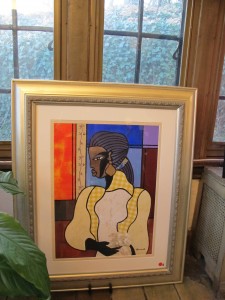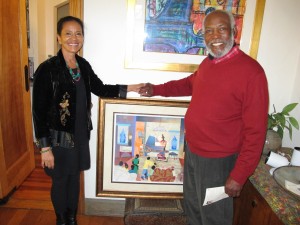Artist James Denmark celebrates Black History month the old-fashioned way—everyday! If Romare Bearden is the ‘Griot for a Global Village,’according to a New York Times article by the same title, then Denmark is his chief disciple. Denmark said that he thrives on being a Black artist. At seventy-plus years old he said that he never struggles with whether he is an artist first or an African American. His art is consistently sought after by galleries worldwide most notably the Metropolitan Museum of Art and Stockholm’s Absolut collection.

Artistic Narratives: During a recent conversation, Denmark said embracing his heritage, music, language and spiritualty is very freeing. He believes that his artistic narratives have no borders calling his approach improvisational. Like jazz, his collages and paintings speak a universal language. Denmark incorporates hand-colored paper and found materials. He captures sounds, sights, flavors and aromas: “I am driven, guided and directed by the spirits.”
Generations: Denmark is currently being recognized along with his artist grandson Demetric Denmark in a show entitled ‘Generations’ at Beaufort Arts Council Gallery through 2/29. Go to www.beaufortcountyarts.com/gallery.htm
“That should be our purpose in life– to pass on the knowledge about our culture and history to the next generation. I am so proud that my grandson is following in my footsteps.”
Mentors: “Romey was my mentor as were all of the giants of the Black art scene—Romare Bearden, Jacob Lawrence, Norman Lewis, Hale Woodruff. I knew all of the artists from the Harlem Renaissance– Ernest Crichlow, among others. There were very few galleries open to them but they forged ahead anyway. They felt dedicated to our narrative. Romey said that it was our job to tell our story. We could not get off course. I always felt that if I could create art—painting, ceramic, glass or collage and you looked at it and could feel like you were in that church, witnessing that event, in that city or out in those marshes, then I had done my job as an artist. That is still my goal.”
“Romey said when you can work or create art to express what you experienced, the viewer will be drawn in to hear or see what you heard in your unharnessed artistic expression of ideas of the music, prayer or your surroundings as it was put to you—that’s what an artist’s job is about.”
Loving Yemassee: “Moving to Yemassee, SC, 11 years ago from Brooklyn has been tremendous. A lot of us are not exposed to the staying power of African culture in America. The warm and welcoming Gullah people definitely made an impact on me. They are now my people. I love it here. They have an accent and language that you don’t hear anyway but here. Their culture in these marshes has existed intact for generations from their basket weaving traditions to their cooking ways.
New York Love: Of course we all miss Jimmy, as family call him, here in New York. Actually, I claim him as a cousin because he is my childhood friend Deidra Perry Titus’ cousin; her brother Nicky is my play brother. Jimmy and wife Ethel hang out with their mother Helen also living in Yemassee who was my mother’s dear friend. So when word got out that the Winter Haven, Florida native would be featured in a solo show at Mount Vernon’s Mackey Twins Art (www.mackeytwinsart.com), we were there. (Mackey Twins Art Gallery was founded in 2005 by twin sisters Karen and Sharon Mackey who are dedicated to supporting artists of color who are not sufficiently represented in larger art venues.) On view were his urban, jazzy collages, scenes, watercolors, and acrylics, including his newer Low Country works so bright and colorful. Rumor has it that all of the 65 paintings sold out as fans and admirers streamed to this home-based gallery for three days. Now that’s a lot of love!

Family Background: Denmark credits his grandparents as his first inspiration. His grandmother was a quilting artist and wire sculptor. His grandfather, a bricklayer, was famous for his custom design molds. His mother was also an interior designer with an eye for detail. African-American women are a central theme in his art even though he credits his male-oriented family of over 30 male first cousins with giving him a solid foundation. “As boys, we were held to a task in the Southern tradition where manhood was stressed. When you reached 12, you were considered a man. Each of us had to mind our manners, excel in school, be responsible, develop skills and talents in a lot of things.”
Education: Reared in racially segregated Florida, Denmark believes that he received a superior education compared to what kids receive today. “I was mentored by Black professors at FAMU (Florida Agricultural & Mechanical University, Tallahassee, Fla.) where I was admitted on a sports scholarship. I became an apprentice to noted art historian Dr. Samuel Lewis. FAMU at that time had the best, brightest and largest number of Black art faculty in the world. All of them had PhDs and advanced degrees in fine arts, architectural, engineering. As I was an honor student, they each mentored me by making me their apprentice — in drawing, painting, design, graphics, sculpture, ceramics and most importantly the African-American art movement. I taught classes as their assistant while still an undergrad student.”
‘A Miracle’: While working on his MFA at Pratt Institute, living and teaching in NYC, Denmark was nurtured by abstract artists Jackson Pollack, Clifford Still and William DeKooning. “Coming to Pratt expanded my vision and it was a miracle to find Jacob Lawrence already teaching there. He introduced me to those expressionists and the Harlem Renaissance artists. I leap-frogged from the classroom to running with the lions of the real art world. It’s still a dream that I am living today. I could not have planned my life. I was lucky to be at the right place at the right time. “
Teacher, Art Therapist: “I believe that art education affirms your inner core and personality. Sadly, many young people don’t know their inner being. They have replaced it with electronics, phones and computers.” Denmark double-majored in Fine Arts and Art Therapy at Pratt, which earned him Special Education credentials. ‘I had a lot of fun teaching all kinds of students. I saw some real talent and creations that were grotesque. I encouraged my handicapped and mentally challenged students in artistic self-expression and left it up to the psychiatrists to interpret.”
In the Studio: “I always worked at my studios at night and on weekends. I worked at 15 Green Street, Soho when the rents were cheap. I lived on Jay Street and my Brooklyn studio was on Washington Avenue near Brooklyn Navy Yard.” After retiring from 34 years in the NYC public school system and setting up shop at his Yemassee studio, Denmark’s art spirits are soaring.
